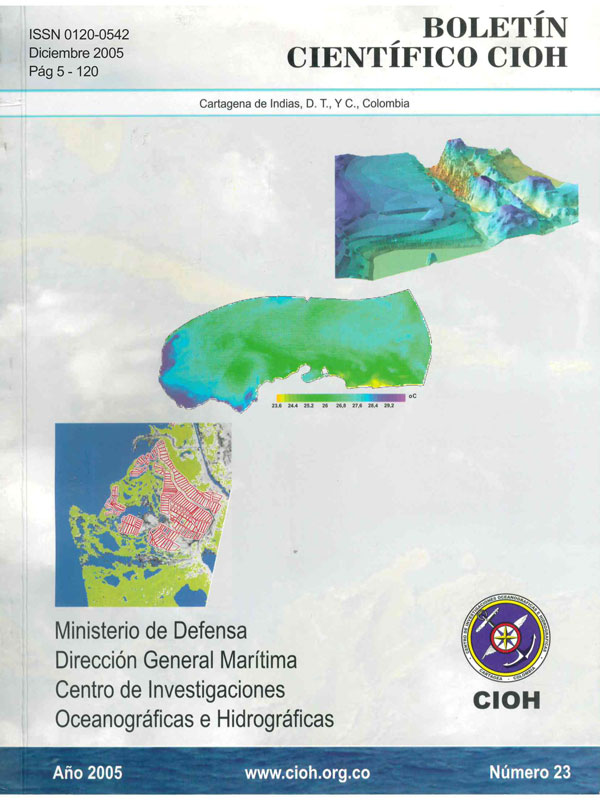Estudio y evaluación de alternativas de solución para la protección costera de unos sectores de la costa Caribe colombiana
DOI:
https://doi.org/10.26640/22159045.141Keywords:
Caribbean, Colombia, coastal erosion, morphodynamicAbstract
The Dirección General Marítima (DIMAR) commissioned the CIOH with the technical support of Aqua&Terra Consulting, to develop the project “Estudio y evaluación de alternativas de solución para la PROtección costera de unos sectores de la costa CAribe colombiana - EPROCA” during the year 2004 and 2005. The specific objectives of the project were to carry out a study of the coastline between Punta Caribana and the Sinú delta, to get a good understanding of the serious problems caused by coastal erosion in the area and to obtain the necessary information to characterise the hydrodynamics of the zone, so as to be able to develop a morphodynamic model, which would describe the systems’ specific dynamics, in order to evaluate different shore protection solutions for this ColombianCaribbean coastal region. This paper is an abstract from this project, detailing the principal results that were obtained.Downloads
References
Banton, J. D. (2002). Parametric Models and Methods of Hindcast Analysis for Hurricane Waves. IHE / Alkyon. MSc. Thesis Report.
Birkemeier, W. A. (1985). Field data on seaward limit of profile change. J. Waterways, Port, Coastal end Ocean Engineering, ASCE, 111, pp.598-602.
Calverly, M. J., D. Szabo, V. J. Cardone, E. A. Orelup y M. J. Parsons (2002). Wave climate study of the Caribbean Sea, Proceedings of 7th International Workshop on Wave Hindcasting and Fore casting.
Chevillot Ph., A. Molina, L. Giraldo, C. Molina(1993). Estudio Geológico e Hidrológico delgolfo de Urabá, Boletín Científico CIOH, (14),pp. 79-89.
CIOH (1991). Condiciones Generales Climáticas Oceanográficas y Geomorfológicas, Golfo de Urabá, Anexo D, Centro de Investigaciones Oceanográficas e Hidrográficas – CIOH.
Cooper, C. K. (1988). Parametric Models of Hurricane - Generated Winds, Waves and Currents in Deep Water, Proceedings of 20th Annual OTC, Houston, Texas, USA. pp 475-484.
CORPOURABÁ - UNIVERSIDAD NACIONAL (1998). Informe Final sobre la “Evaluación de Zonas de Erosión Crítica en el Litoral Caribe Antioqueño”, Posgrado en Aprovechamiento de Recursos Hidráulicos, Medellín, 1999p.
Correa I. D. (1990). Inventario de Erosión y Acreción Litoral (1793-1990) entre Los Morros y Galerazamba, Departamento de Bolívar, Colombia. En: Hermelin M. (ed.) Memorias del Primer Seminario Andino de Geología Ambiental-I Conferencia Colombiana de Geología Ambiental. Agid Report No. 13.
Dean, R. G. (1991). Equilibrium beach profiles: Characteristics and application. J. Of Coastal Research, 7.
Dirección General de Puertos de España (1991). Estudio sobre las observaciones visuales de barcos en ruta del N.C.D.C. Programa deClima Marítimo. Publicación No. 46.
Duque-Caro, H. (1984). Estilo estructural, diapirismo y episodios de acrecimiento del terreno Sinú – San Jacinto en el Noroccidente de Colombia. Boletín Geológico INGEOMINAS. 27, (2), pp. 1-29.
Goda, Y. (1988). On the Methodology of Selecting Design Wave Height. Proceedings of the 21st International Conference in Coastal Engineering, pp. 899-913.
González, M. (1995). Morfología de playas en equilibrio. Planta y perfil. Tesis Doctoral.Universidad de Cantabria.
Hsu, J. R. C. y C. Evans (1989). Parabolic bay shapes and applications, Proc. of the Institution of Civil Engrs., 87, (2), pp. 557-570.
IDEAM (2005). Pronóstico de Pleamares y Baja mares Costa Caribe Colombiana, IDEAM,Bogotá, D. C.
INVEMAR (2002). NCCSAP, Colombia:Definición de los sistemas bio - geofísicos y socioeconómicos debido a un cambio en el nivel del mar en la Zonas Costeras colombianas (Caribe, Insular y Pacífico) y medidas para su adaptación, Informe Técnico No. 4, Evaluación de Impactos, Efectos y Respuestas del Sistema Natural, Santa Marta, Colombia. 107 p + anexos.
INVEMAR (2004). Posibilidades de Reconstrucción de Punta Arboletes (Límites entre los departamentos de Antioquia y Córdoba). Restrepo et al.: Estudio alternativas solución para protección costera costa Caribe colombiana. Laboratorio de Ensayos Hidráulicos de las Flores (1995). Obras de protección costera y muelle para embarcaciones menores, Puerto Escondido – Cordoba, Barranquilla. Molares, R. (2004). Clasificación e Identificación de las Componentes de Marea del Caribe Colombiano, Boletín Científico CIOH, (22), pp. 105-114.
Molina, A., C. Molina, Ph. Chevillot (1992). La Percepción Remota Aplicada paraDeterminar la Circulación de las Aguas Superficiales del Golfo de Urabá y Las Variaciones de su Línea de Costa. Boletín Científico CIOH, (11), pp. 43-58.
Page, W. (1986). Geología sísmica y sismicidad del Noroeste de Colombia. ISA-INTEGRAL-WOODWA R D - C LYDE CONSULTANTS. Versión española por Rodrigo Alvarez, Ingeniería e Hidrosistemas IEH Ltda.156p.
Palacio, H y A. Restrepo (1999). Influencia dela evolución del delta del río Sinú en los procesos morfodinámicos del litoral Caribe Antioqueño, TDG Ingeniería Civil, Universidad Nacional de Colombia, sede Medellín.
Robertson, K. (1989). Evolución reciente del delta del Río Sinú, Colombia, Cours International d’Océanographie Côtière en Région Caraïbe, Bull. IGBA, Bordeaux, (45), pp.305-312.
USACE (1984). Shore Protection Manual, U.S. Army Corps of Engineers, Coastal Engineering Research Center (CERC),Vicksburg, Mississippi, 2 vols.
Vernette, G. (1985). La Plate-forme Continentale Caraïbe de Colombie (dudé bouché du Magdalena au Golfe de Morrosquillo). Importance du diapirisme argileux sur la morphologie et la sédimentation. Thèse de Doctorat d’état, Université Bordeaux 1. France, 378 p.
Downloads
Published
Issue
Section
License
Attribution — You must give appropriate credit, provide a link to the license, and indicate if changes were made. You may do so in any reasonable manner, but not in any way that suggests the licensor endorses you or your use.
NonCommercial — You may not use the material for commercial purposes.
NoDerivatives — If you remix, transform, or build upon the material, you may not distribute the modified material.
No additional restrictions — You may not apply legal terms or technological measures that legally restrict others from doing anything the license permits.



